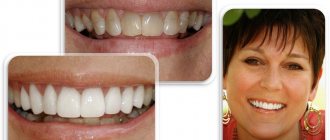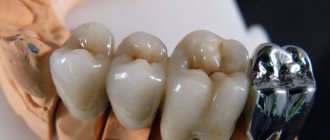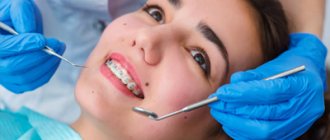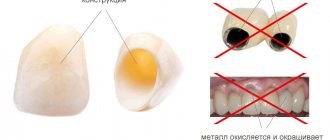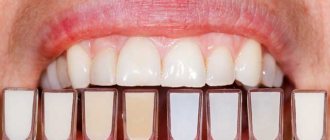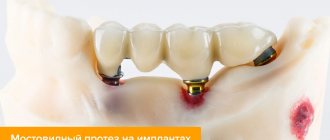When the need for dental prosthetics arises, the question arises - which crowns are best to install. Modern dentistry offers various options for dental crowns. They differ in material, purpose, and manufacturing technology. Each type has its pros and cons, each is recommended for certain indications.
What types of prostheses are there, which ones are better to install?
Crowns are fixed to the visible part of the element using a special dental compound. Prosthetics with crowns allows you to simultaneously restore chewing function and the anatomy of the dentition.
Teeth crowns differ in material and, accordingly, in price. To decide which crowns are best placed in a particular clinical case, you should outline the pros and cons of each type of prosthesis
Plastic crowns
Such products are used as temporary crowns. They are lightweight, quick to manufacture and inexpensive. The structures are fixed to ground teeth or implants (while the permanent prosthesis is being prepared).
The mission of temporary crowns is to evenly distribute the chewing load on the dentition, while reducing the risk of developing bone atrophy in the jaw and further accelerating the process of getting used to the permanent prosthetic structure.
Metal-plastic crowns
The most inexpensive option for prosthetics. The crown is based on a metal alloy (cobalt, chromium, nickel). To give the prosthesis a natural appearance, the base is covered with a layer of plastic. In case of minor chips in the material, the product can be repaired directly in the patient’s mouth.
Metal-plastic structures are not strong enough - they can last a person up to 3 years. Over time, products lose color, slightly increase in size, and can cause allergies.
Metal ceramics
Metal-ceramic crowns are the true “golden mean” - the products are quite reliable and aesthetic. The surface of the prosthesis is ceramic, and the base is a metal alloy.
When making dentures from precious metals (gold, silver, palladium), you can count on a more natural appearance of the structure. In this case, the metal base will not give off a grayish tint through the coating, as is the case with conventional metals.
The relatively low price of metal-ceramic prosthetics with its acceptable functional and aesthetic indicators makes this method of tooth restoration the most popular. However, before making a choice in favor of metal ceramics, it is worth considering the risk of developing an allergy to metal, as well as the minimal likelihood of chipping the ceramic coating.
Metal crowns
This type of prosthesis is less popular these days. The product looks like a metal cap that is placed on a damaged tooth or titanium root. The strength of these crowns is enviable. A significant disadvantage of such products is their unaesthetic appearance: metal in the oral cavity is difficult to hide from prying eyes.
The denture is made in a dental laboratory. The basis is steel, titanium, as well as gold and platinum. In dentistry, there are two types of metal crowns:
- stamped. These are standard caps that are given an individual shape in the patient’s mouth. The products have thin walls, so they wear out quickly and are very rarely used in practice;
- cast. The designs are prepared on the basis of personal casts. This technique makes it possible to produce dentures that fit perfectly to hard tissue, eliminating the spread of bacteria in the space between the denture and dental tissue.
In the process of manufacturing metal crowns, spraying technology is often used. The material for these purposes is chosen at the request of the patient (gold, zirconium dioxide, plate).
Metal-free crowns
This type of crown has the highest aesthetics - it is very difficult to distinguish them from natural teeth. The following materials can be used in the production of prostheses:
- porcelain or pressed ceramics. The most attractive looking crowns. They are inferior to their analogues in strength, but are absolutely safe for the patient - they have a high biocompatibility index;
- zirconium dioxide. A durable material that is superior to alternative options in aesthetics - teeth with such crowns look like natural ones in the mouth. Other advantages of zirconium dioxide crowns include: safety, resistance to breakage, long service life;
- aluminium oxide. This material is slightly lighter than zirconia, making it most preferred when restoring anterior teeth. Products made from aluminum oxide are hypoallergenic and do not change their shade.
What types of crowns are there?
A crown is a prosthesis for a tooth. Its main goal is not only to imitate a healthy tooth, but also to preserve the one underneath, to fully perform the chewing function, biting, if the installation is planned on the front teeth, to restore aesthetics, and to return a beautiful smile. Again, this is relevant if this concerns the frontal zone.
Which crowns are best to choose? First, it’s worth considering their types. Based on materials, they are divided into:
- metal;
- metal-ceramic;
- all-ceramic;
- metal-plastic;
- zirconium.
In each of the above types of dental crowns there is also a variety.
Metal crowns.
Cobalt-chromium alloy or nickel-chromium alloy is the most budget-friendly option for prosthetics. But they are used less and less. Such crowns can cause an allergic reaction, which the dentist immediately warns about before installing them. During use, the patient feels an unpleasant, metallic taste in the mouth. Another significant disadvantage is the lack of aesthetics.
Crowns made of precious metals
: gold, silver, platinum, titanium. Metal crowns are often solid. Using variations of alloys from them, they try to achieve better biocompatibility, which they have. Reliable, durable, but lacking aesthetics. If they serve as the basis for metal-ceramics, followed by the application of ceramic mass, then the issue of similarity with natural teeth becomes irrelevant. The result is a very natural prosthesis that will serve faithfully for years.
Metal-ceramic
The type of crown is by far the most popular and frequently used. Ceramic is applied layer by layer onto the metal frame. In some dental laboratories they are made using 3D modeling. The patient often makes this choice based on the average price and guaranteed quality. The method of metal-ceramic prosthetics has been used so often and for many years that the technology has been proven and is absolutely predictable.
All-ceramic
the prosthesis is made in several ways: by firing ceramics using a refractory mold, by pressing under pressure (E-max), by milling using CAD/CAM technology. Porcelain is an inert, safe material; a ceramic prosthesis is always a good match for its visual similarity to natural teeth. Has the same transparency. Metal-free crowns can be confidently placed on the front teeth.
Metal-plastic
or
plastic
crowns are placed while a permanent structure is being made or time is needed for healing after implantation.
Zirconium
(zirconium dioxide) is a good choice in all respects. The best types of crowns for teeth. Using CAD/CAM computer modeling on fully automated equipment, a crown is created from a monolithic material using a high-precision milling cutter. Aesthetic, reliable, wear-resistant, hypoallergenic.
Whether it will be installed on a tooth or crowns on implants, or whether it will be an integral part of the bridge prosthesis design simulating a missing element of the dentition, affects which crowns to choose.
During implantation, crowns are placed on an artificial tooth, with an abutment
. And the following types of dental crowns are preferred: ceramic, metal-ceramic, zirconium.
Comparative characteristics of different types of dental crowns
The table below shows the characteristics of popular types of dental crowns. This information should be taken into account when choosing crowns for the front or chewing teeth.
| Comparison parameter | Metal ceramics + gold, silver, palladium | Metal ceramics + nickel, chrome | Pressed ceramics | Zirconium | Aluminium oxide | Metal-plastic |
| Possibilities of prosthetics | ||||||
| Single restoration | + | + | + | + | + | + |
| As part of a dental bridge | + | + | + | + | + | + |
| For metal intolerance | + | — | + | + | + | — |
| For sore gums | + | — | + | + | + | — |
| For sensitive enamel layer | — | — | + | + | + | + |
| Qualitative characteristics | ||||||
| Possibility of fixing without turning | — | — | + | — | — | — |
| Probability of chipping (scale - 5 points) | 2 | 3 | 3 | 1 | 1 | 5 |
| Maintaining aesthetics in % | 80 | 70 | 100 | 100 | 100 | 20 |
| Production | ||||||
| Manual technique | + | + | — | — | — | + |
| Computer modelling | — | — | + | + | + | — |
Which crowns are best for back teeth?
The lateral teeth bear the basic load, so for their reconstruction it is worth using the strongest prosthetic products. Aesthetics in this case are less important. However, not any unaesthetic material (metal) will be compatible with soft tissues - this is also worth taking into account when choosing crowns for molars.
Metal prostheses are reliable and inexpensive, they very rarely break. The disadvantages of prosthetics with metal crowns are a low level of aesthetics and a high risk of developing allergies.
You can solve the problem of material incompatibility with fabrics by choosing products made of precious metals (gold-platinum alloy) for installation. They are safe and non-toxic. However, the price of a crown will be comparable to the cost of a ceramic product.
The most preferred option for prosthetics of lateral teeth remains metal-ceramics. This choice of most patients can be called justified, because a metal-ceramic crown is an excellent ratio of price and quality. Compared to a metal structure, such a prosthesis is inferior only in strength (there is a risk of chipping the ceramic coating). Blueness of the gums, which is formed as a result of contact between metal and soft tissues, is not embarrassing, since we are talking about prosthetics in the area of chewing teeth.
It is not recommended to place all-ceramic structures on teeth, since they are not very durable - there is a high risk of chipping and breaking. An alternative to classic ceramics can only be E-max glass ceramics - a durable analogue at a higher price.
Products made from zirconium dioxide are the strongest and most durable, which is why they are often recommended for use in dental restoration. However, in this case, it is preferable to use exclusively monolithic zirconium crowns (the veneer may break off).
Plastic dentures
Dentures are made by technicians from modern polymers. You can choose a shade of plastic that matches your “neighbors.” Dentures for one tooth, several teeth, and even complete removable plastic dentures are made from plastic.
- Advantages - this is the cheapest option for dental prosthetics. In addition, a plastic prosthesis for 1-2-3 teeth is quickly manufactured, which means that the patient does not have to suffer from an aesthetic and functional defect for a long time. The prosthesis is lightweight and therefore comfortable.
- Disadvantages - orthopedic products made of plastic are very fragile, so they are used only for temporary prosthetics.
Which crowns are best placed in the smile area?
When fixing crowns on the front teeth, much attention is paid to the aesthetics of the result. The main task of the prosthesis is to be strong enough and not stand out against the background of natural teeth. When restoring the upper and lower dentition, identical design options are used.
Today, metal crowns are not placed on the front teeth. This statement is true both for products made of ordinary metals and precious ones.
Metal-ceramics is a good-priced, but aesthetically controversial, prosthetic option. The metal base of the structure is visible through the ceramics; over time, a bluish rim forms at the site of contact of the gums with the metal. To eliminate the second drawback, dentists offer to install metal-ceramic crowns with shoulder mass on the front teeth. However, this type of prosthetics is more expensive.
Prostheses made of medical porcelain or pressed ceramics are the best option for prosthetics of the frontal area. The crowns look good and are able to withstand the load placed on this area. The price of the products is quite affordable.
Constructions made of zirconium dioxide (aluminum oxide) should be installed if the color of the teeth in the smile area is significantly changed. In this case, a zirconium frame and porcelain lining will be the best option. The cost of such prosthetics is comparable to the price of ceramic crowns.
Which crowns are best for front teeth?
For the front teeth, crowns with the highest aesthetic rating should be selected. They should not differ from the other elements of the front row. The load, of course, is not the same as on chewing teeth, but biting food with incisors implies a margin of safety.
- ceramic.
The amazing ability to absorb light rather than reflect it from the surface, porcelain's transparency makes the imitation of a natural tooth excellent. - zirconium.
They are on par with ceramic ones in aesthetics, but are more durable. For the front teeth, it is worth considering getting these crowns if you have the financial opportunity. - metal-ceramic.
This is the answer to the question of which crown to put on your front teeth inexpensively. In this case, it is necessary to take into account the possibility of cyanosis in the area of contact between the gums and the metal base of the prosthesis. To avoid this, a metal-ceramic crown with shoulder mass is installed. The tooth is ground a little more, with a ledge. And more area is covered with ceramics. To solve this problem, noble inert metal alloys can be used for the crown frame. All this increases the price of prosthetics.
Metal-ceramics can shine through the gums, which is undesirable for the front group of teeth
Comparison table for crowns made of different materials:
| Aesthetics | Strength | Life time | Price | Notes | |
| Dental metal (cobalt-chrome, etc.) | low | high | long | low | possible allergies, bluish gums |
| Noble metals (gold, etc.) | low | high | long | high | possible allergies, “blueness” of the gums (solved by using precious metals in the base) |
| Metal ceramics | above average | average | average | average | |
| Ceramics | high | average | average | high | |
| Zirconium dioxide | high | high | long | high | |
| Metal-plastic | average | low | short | low | for temporary purposes |
Expert of the article Alekperov Roman Borisovich Dentist-orthopedist, doctor of the first category
Work experience24 years
Service life of dental crowns made of different materials
The most short-lived are temporary crowns on teeth (plastic). In second place in terms of durability are products made of metal-plastic. The longest service life of structures is 5 years. However, patient reviews “speak” of premature darkening and deformation of the crowns.
Metal-ceramic dentures, which are successfully fixed to both the front and chewing teeth, usually last about 10 years. Artificial teeth made of ceramics remain the same in appearance and functionality for 10-15 years.
Metal crowns made of metal alloys last a long time and last at least 15 years.
Expensive materials - zirconium dioxide and aluminum oxide - last up to 20 years. The long service life justifies their high cost.
The service life of prosthetic structures is determined not only by the quality of their manufacture, but also by the care they are provided after installation.
What types of crowns are there and which ones are best?
A crown is a non-removable dental prosthesis, which is intended to completely eliminate all existing aesthetic and functional defects of the tooth. In order to strengthen the strength of the tooth, restore its shape and size, and also make it more resistant to chewing loads, dentures of this type are used. If the crown part of the tooth is destroyed by more than 50%, we can definitely recommend installing a crown. This will allow 100% restoration of the function of the tooth and protect it (including the root) from further destruction. Often crowns are an integral part of a larger prosthesis.
all-metal or gold-plated crowns were most often used in dentistry ; wealthier people could afford an all-gold crown. Now crowns made of stainless steel, brass or medical metal are the most affordable prostheses. They are quite durable and do not wear out; they can last up to 15-20 years.
The advantages of metal crowns: strength, long service life and low cost; before installing crowns, there is no need to sharpen the teeth. Disadvantages of metal crowns: metal taste in the mouth, there may also be a burning sensation, unsightly appearance, possible allergic reactions to metal.
They are mainly used on chewing teeth as temporary ones if treatment requires a long time, for example, when restoring the function of the TMJ.
Plastic crowns are the cheapest. They are made both in the laboratory (precisely) and directly at the reception (direct method). It should be noted that modern 3D modeling and printing technologies make it possible to produce them in a clinical setting with high precision. They wear out faster than others. Plastic crowns are usually used for temporary restorations; their main advantage is rapid production, as well as relatively low cost and acceptable aesthetics. The main disadvantage is its fragility and the possibility of an unpleasant odor from under the crown; this problem can be solved quickly by reinstalling the crown.
Metal-ceramic are crowns made of a metal frame, coated on the outside with an aesthetic ceramic mass. These crowns have high aesthetics. In the vast majority of patients they do not cause allergic reactions, are inexpensive and have good biological compatibility. The most commonly used materials used to make the frame of products are an alloy of chromium with nickel or cobalt. Alloys made of precious metals (gold or platinum) are completely hypoallergenic and more aesthetically pleasing, but the price of such crowns is also higher.
The advantages of metal-ceramic crowns: they can easily withstand heavy loads during chewing, the service life of metal-ceramics reaches more than 10-15 years, they have an elegant appearance and are visually almost the same as natural teeth, and are relatively inexpensive. Disadvantages: before installing metal-ceramics, teeth are subjected to significant grinding (up to 2 mm on both sides), tooth depulpation is usually carried out, after a certain period of time, blue discoloration may appear along the edges of the crowns due to the metal base of the structure, when installing dentures of one or a pair of teeth, There will likely be a difference between the natural teeth and the crown, especially under certain types of lighting, see below for details.
Ceramic (Impress and E.max) . Ceramic crowns began to be manufactured for use on the frontal group of teeth. They look natural and are practically no different from your own incisor teeth; they often look better, which is why they are used to create a “Hollywood smile.”
A ceramic crown can withstand less load than a metal-ceramic crown, because... does not have a metal frame. It is rarely used as a prosthesis for chewing teeth and is not used on implants, but this technology is used in the manufacture of veneers, lumineers or orthopedic inlays. These designs provide naturalness and aesthetics to perfection.
Advantages of ceramics: long service life and reliability – high degree of aesthetics. Even in good natural light, ceramic products do not differ from true incisors in color and transparency. Restoring teeth using such crowns will not affect the condition of the gums and oral cavity, thanks to the biocompatibility of ceramics. Disadvantages: the material does not tolerate even minor errors - the likelihood of chipping and damage to the crown if placed incorrectly. Pure ceramics are used only for single crowns or microprostheses; bridges cannot be made using this technology; the cost is higher than that of metal-ceramic crowns; they are ideal for frontal teeth.
Ceramic crowns with a zirconium dioxide frame . They are distinguished from ordinary ceramics by greater strength, while their natural appearance is not very different, and from metal-ceramics they have a thinner frame, which makes it possible to produce products with a wall thickness of 0.4-0.5 mm - significantly less teeth need to be prepared. They fit tightly to the teeth, preventing the development of caries - the main reason for repeated prosthetics. The aesthetics of crowns on a zirconium dioxide frame are much superior to the aesthetics of metal-ceramics (due to light transmission) and are slightly inferior to all-ceramic crowns. The mechanical properties of zirconium dioxide make it possible to install them on implants and create bridge-like structures.
The 100% absence of the risk of allergies is also important; even in comparison with crowns made of precious metal alloys, zirconium has good biocompatibility, which distinguishes it favorably from metal-ceramics. The use of this material does not have a negative effect on either the gum tissue or the body as a whole.
How to properly care for dental crowns
Following simple recommendations for caring for dentures will help extend the “life” of dental crowns. Regardless of the material of manufacture, dentists advise patients to provide the structures with the following care:
- brush your teeth using a toothbrush and toothpaste twice a day (morning and evening). Clean not only teeth, but also cheeks and tongue from plaque;
- use a paste of medium (soft) abrasiveness. Large particles in pastes harm not only the enamel of natural teeth, but also the surface of dentures;
- Clean spaces between teeth using dental floss. As an alternative, you can use a irrigator or a special brush;
- when wearing a bridge, it is good to clean the intermediate crown;
- rinse your mouth with mouthwash or running water after each meal;
- limit the consumption of foods with dyes - coffee, black tea, chocolate, red wine, etc.;
- do not overload dentures - do not eat too hard foods, get rid of bad habits (do not open lids with your teeth, do not chew a pencil, etc.);
- Avoid sudden temperature changes that can cause chipping of the ceramic layer.
For preventive purposes, the patient is recommended to visit the dentist every six months; at the same interval, the patient is recommended to undergo professional cleaning of the oral cavity.
Reviews from doctors and patients
Dentists consider dentures with crowns to be an excellent way to restore significantly damaged elements. Doctors note a significant advantage of this solution - it is an opportunity to prevent the destruction of a “dead” tooth or even preserve a “living” unit (if it is partially destroyed). This method cannot be called universal only because it has a number of contraindications, one of which is root damage.
Patients, for the most part, speak positively about prostheses of this type. They note the rapid restoration of functionality and aesthetics of the series, ease of use and durability of the prostheses.
How to choose a clinic for crown prosthetics
Only experienced specialists in a dental clinic that has proven itself to be the best will help you choose which crowns to install. This can be seen from reviews and recommendations from friends. If the clinic has its own dental laboratory, then this only increases loyalty to it. The dialogue between the dentist and the dental technician takes place directly on the spot, in the same language. This increases the likelihood of high-quality execution of the prosthesis.
If you are wondering how to choose a clinic for crown prosthetics, pay attention to:
- licenses of the clinic and doctors;
- wide range of services;
- modern equipment;
- cleanliness and sterility;
- reviews.
Take advantage of a free consultation. This way you can evaluate the approach to patients, the plan for dental prosthetics and your personal feelings.
